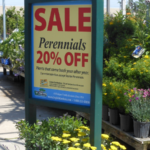Return Policy Power
Crafting a good return policy is a challenge for any retailer, but for those in the lawn and garden industry (whose products are mostly perishable), that task is even more difficult. From retail fraud to consistently enforcing the policy, there are many factors to ensure both you and your customer walk away from a return transaction satisfied.
Approaching The Policy
How you approach your returns policy and each individual return makes all the difference. Professor Patrick Dunne of the Rawles College of Business at Texas Tech University recommends erring toward generosity. “How you handle returns can be the difference between turning a profit and losing money,” he said. “It takes fives times as much investment to bring a new customer into the store as it does to deal with an unhappy customer. And only about 1 percent of all returns are fraudulent, so you have to think, ‘Do I want to damage this relationship or not?'”
Carol Kaufman-Scarborough, a professor of retail marketing at Rutgers University, agrees. “Recognize that most customers do not intend to make returns, but they may find their skills with plants are very different than their abilities to buy things that are purchased frequently. Lawn and garden retailers should try to build relationships rather than 1-time sales. If a customer returns a plant, it should be viewed as an opportunity to educate the customer or steer them toward the choices that fit their skill sets and environmental requirements,” she said.
Dan Butler, vice president of merchandising and retail operations for the National Retail Federation, said treating consumers evenly and fairly is extremely important. “It’s not that you can’t make exceptions, but you can train the staff to execute the policy equally and make exceptions in a consistent way. If you don’t, you leave yourself open to complaints of discrimination. And you don’t want to give a customer cash back one time and allow only a store credit the next.”
In fact, many experts say the way customer returns are handled is much more important than the actual policy itself. Even when the return is eventually settled in favor of the customer, if the path was torturous, the experience will be viewed negatively.
Creating Garden Center Policies
A complication for lawn and garden retailers is they carry a wide range of product types that may require different return policies: Green goods may have one return policy and hard goods another, for example. “If a specific item has a policy specific to that product, it should be on a sticker or hang tag on the product,” suggested Butler.
At Home Depot, for example, most garden goods can be returned within 90 days with a receipt. But gasoline-powered equipment must be returned within 30 days with the original receipt. Live goods also require a receipt but can be returned for up to 12 months from the purchase date. Costco has a simpler system everything in the garden department can be returned in any condition, at any time and for any reason with a receipt.
Independent garden centers have different policies. “We’re one of the few garden centers I know that warrantee annuals,” explained Ed Knapton, owner of America’s Best Flowers, Cottage Grove, Wis. “If you’re going to replace a tree or perennial, why not replace an annual?”
His return policy states the garden center will replace anything within the growing season it was purchased (until first frost) with a replacement or a store credit but not cash. Members of the store’s loyalty club do not need a receipt. “We’re out in the country,” said Knapton. “People have to drive back out to us. With gas prices what they are, it could cost six bucks in gas just to return something. So we don’t have a big problem with returns. It’s a simple policy, it’s simple to teach the staff and everyone’s happy.”
Matt Horn, owner of the Matterhorn Nursery, Spring Valley, N.Y., has a different opinion, but his garden center still takes plants back. “I don’t think people should be warranting plants,” he explained. “A doctor doesn’t guarantee your health after you leave his office. We stand behind everything we sell. Period. But I can’t control what people are doing to these plants once they get them home. It seems like industry wide everyone takes plants back, so we do, too. We ask our customers to bring the plant back so we can diagnose what went wrong; that way we can help prevent it from happening to the replacement. And sometimes we take the opportunity to suggest something else that is better suited.”
Benefits Of Returns
Horn’s tactic of steering an unhappy customer toward a better solution is a good one. Even if returns fraud is not a huge concern, a good return policy enacted by a good employee can turn a dissatisfied customer into a loyal one; provide valuable information on the needs, skill sets and desires of key customers; and help you track products that are not performing well. It can also spotlight possible educational or labeling opportunities, give your customers the confidence to make purchases and help cement personal relationships with your customers.
Knapton tracks returns to see trends or problem areas and better forecast sales figures. What he has found is returns in most areas are pretty minimal. “Fountains have a pretty high return rate for us,” he said. “Our fountains cost about $1,000, and I think people get caught up in that first flush of spring but come back to earth when they see their credit card bills. And there are a few people who buy baskets of annuals early in the season and then return them for baskets of hardy mums late in the season. But it’s the same three or four people every year, and if they feel they have to do that, well, it doesn’t cost us much.”
“Still, we do restrict our returns to the growing season,” Knapton added. “If you didn’t do that and had a bad winter, you could get a 10-percent return rate. That’s significant enough to factor that into your projections,” he said.
What About Fraud?
Return frauds cost the retail industry $16 billion in 2003, the last year such figures were available, according to King Rogers of KingRogers International, a security and loss prevention consulting firm. “And that was trending up significantly,” he said. “The 2003 figures showed a 23-percent increase in returns fraud over 2002.”
A return policy can form the framework to help prune returns fraud, but just how concerned should a lawn and garden retailer be about fraud?
Nine percent of all retail returns are fraudulent, but only 1 percent of all consumers are responsible for fraudulent or abusive behavior. Merchants are squeezed on one side by skyrocketing return rates and on the other by legitimate customers annoyed by less flexible returns policies. A 2004 Harris Poll found that 91 percent of consumers interviewed considered return policies and processes important to their decisions about where to make a purchase.
“Retailers can train employees to recognize fraud and make judgments on a case-by-case basis,” said Joseph LaRocca, vice president of loss prevention at the National Retail Federation. “Merchants must constantly be analyzing their returns to determine what the best solutions for them may be,” he said. “There is, unfortunately, no one-size-fits-all policy.”
Common Fraud
Retail returns rates may not apply easily to lawn and garden stores. Nearly 51 percent of all return fraud falls into the category of “renting/wardrobing.” In other words, consumers buy goods with the intention of returning them after use: Large-screen TVs are bought before the Super Bowl and returned afterward.
Although the average lawn and garden store does have products that can be “rented” such as expensive tools purchased and returned after a 1-time use or potted plants purchased to decorate for a party or open house and returned compared to electronics or clothing retailers, those situations are relatively rare. And the professional fraud rings lean toward highly portable, non-identifiable goods like jewelry or small electronics. Live goods are simply too heavy and difficult to pawn if the return scam goes awry to attract many professional thieves.
So for garden retailers, cracking down on theft may be less important in crafting a return policy than maintaining a clear and consistent policy for all customers.
Make It Known
Posting your returns policy prominently is also important not only to avoid running afoul with the FTC or local consumer watchdog groups but also to reassure your customers. The Harris Poll shows that although consumers preferred lenient return policies, they were more concerned about unclear or unposted policies and were less likely to buy from retailers whose policies were unknown to them.
Knapton, for example, posts his return policy near his registers, among the perennials, on the wall of the greenhouse, on his Web site and on the sales receipts themselves. “Our POS system was one of the best decisions we ever made for a number of reasons,” he said. “But even if customers don’t read the receipt at the time they get it, when they’re unhappy, one of the first things they do is go get their receipts. And it’s all spelled out right there for them.”
“A return is always fraught with anxiety for the customer and the retailer both,” said Dunne. “The really great retailers are the ones who can turn the encounter into a good experience for both parties. Customers especially if they are unsure of whether the retailer will even accept the return may start out rude or combative, and it takes a cool head not to respond in kind. But if you can turn it into a conversation about what they expected and how it turned out and then offer solutions you can earn a devoted customer for life.”


















 Videos
Videos





